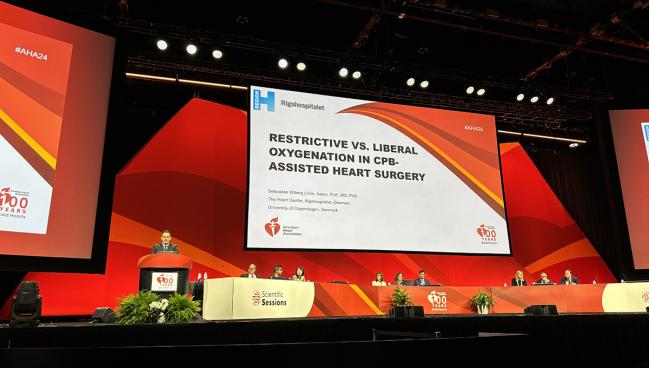GLORIOUS: Neither Exenatide Nor Restrictive Oxygenation Boost CV Surgery Outcomes
The two strategies, used to reduce renal, brain, and heart injury after surgery, were ineffective, but the story isn’t done.

CHICAGO, IL—Two strategies used during cardiopulmonary bypass (CPB)-assisted coronary artery surgery and/or valve replacement surgery—one using a glucagon-like peptide 1 (GLP-1) receptor agonist, the other restrictive oxygenation—fail to improve clinical outcomes after surgery, the GLORIOUS study shows.
Neither strategy tested in the 2x2 factorial-designed GLORIOUS trial reduced the risk of mortality or morbidity from renal failure, stroke, or heart failure, researchers reported here at the American Heart Association 2024 Scientific Sessions.
Despite the neutral results, the study helps inform clinical practice, said lead investigator Sebastian Wiberg, MD, PhD (University of Copenhagen, Denmark).
“This is an area where very little knowledge actually exists from randomized trials.,” he told TCTMD. “In the contemporary European guidelines on how to conduct cardiopulmonary bypass, and how you should treat those patients, only seven of 113 recommendations are based on a high level of evidence. There's a huge evidence gap, and we need to start investigating what we're actually doing on a day-to-day basis.”
Cardiac surgeon Subodh Verma, MD (St. Michael’s Hospital, Toronto, Canada), who wasn’t involved in GLORIOUS, praised the investigators for conducting the trial. The two hypotheses, he said, are worthy of study in the quest to improve perioperative outcomes.
“We don't have a lot of large, well-conducted clinical trials in cardiac surgery, per se, particularly in the perioperative scenario,” he told TCTMD.
Sigrid Sandner, MD (Medical University of Vienna, Austria), another cardiac surgeon who commented on the study following the late-breaking presentation, suggested that the interventions may have failed because the CABG/AVR procedures were relatively straightforward, with short median durations of CPB and aortic cross-clamp times (87 and 56 minutes, respectively), and performed in low-risk surgical patients.
“That makes it particularly challenging to detect small or even moderate differences in clinical outcomes,” said Sander.
Verma agreed.
“This is a population of elective patients who are not acutely unwell,” said Verma. “They're not really patients with a very high EuroSCORE, for example, and so for elective patients at low perioperative risk, this strategy does not seem to make a difference. It still doesn't take it off the table, because there is a need to test this hypothesis in vulnerable and high-risk patients because the outcomes might be totally different.”
For Sander, though, it might be best to move on and test other approaches. “The trial results were so neutral in these two study arms, that considering how much we don't know, there’s probably not a big gain from these two interventions,” he said.
Limiting Reactive Oxidative Species
With the restrictive oxygen strategy, “supraphysiological” levels are traditionally used to ensure end-organ oxygen delivery, but Witberg said hyperoxia might result in oxidative damage caused by the production of reactive oxidative species. Additionally, liberal use of oxygen may cause ischemia-reperfusion injury and cardiovascular dysfunction, he said.
As for the GLP-1 receptor agonist, there are animal studies hinting that it may protect against oxidative stress. Other work has suggested the GLP-1 analogs may reduce infarct volume in stroke and acute myocardial infarction animal models. This intervention is a “little more exploratory,” said Witberg, and while data suggest it could be beneficial, “the chance of hitting something that actually works when you do exploratory interventions like that is fairly low.”
In total, 695 patients were randomized to restrictive oxygenation, which was defined as an administered oxygen fraction of 50%, and 694 to treatment with liberal oxygenation, defined as an administered oxygen fraction of 100%, during CPB and in the first hour as they weaned off bypass. Patients were also randomized to a perioperative 6.25-hour infusion of exenatide 17.4 µg or placebo.
The majority of patients (mean age 68 years; male 83.2%) underwent CABG surgery, with 22% undergoing AVR surgery alone. Approximately 10% had a combined CABG/AVR procedure.
After a median follow-up of 5.9 years, neither intervention reduced the primary endpoint of mortality, stroke (as defined by the treating physician), renal failure requiring replacement, and new-onset or worsening heart failure. In fact, event curves were virtually superimposable. In a sensitivity analysis, there was no benefit with either strategy when investigators focused solely on events occurring within the first 180 days.
There was no risk of adverse events with exenatide compared with placebo, but in the restrictive-oxygenation arm, there was a trend toward more surgical site infections (22 vs 11 with liberal oxygenation; P = 0.05).
Possible Reasons for Neutral Results
During her discussion, Sandner said the choice of endpoint and duration of follow-up may have contributed to the neutral results. Focusing on outcome measures affected by myocardial protection, such as those associated with myocardial function, could have increased the ability to detect a treatment effect. Stroke, she said, is the result of embolization of atherosclerotic plaque during surgical manipulation and unlikely to be improved with either intervention.
Additionally, the benefit of either approach is most likely going to occur early. The extended follow-up, even in the sensitivity analysis, may have introduced additional events unrelated to either intervention and diluted the potential treatment effect, said Sandner.
Verma, to TCTMD, said less is known about the appropriate dosing of GLP-1 receptor agonists in the perioperative period and suggested that dose-finding experiments would be needed to better understand the duration of treatment needed in this setting. During the late-breaking trials session, Andrew Sauer, MD (Saint Luke’s Mid America Heart Institute, Kansas City, MO), made a similar point, asking researchers how they arrived at the exenatide dose.
Wiberg said they can’t rule out the possibility that another dose would be more effective, but said they did a parallel study testing the dose in patients with cardiovascular disease and observed a treatment effect on various physiological markers suggesting efficacy.
In general, Verma said it would be ideal if GLP-1 receptor agonists, such as semaglutide (Ozempic/Wegovy; Novo Nordisk), were introduced as part of a comprehensive approach to cardiac surgery. Prehabilitation using the drugs would provide patients with the benefits of treatment, including cardiometabolic remodeling, prior to surgery, as well as the associated weight loss.
The researchers are currently in the midst of conducting GLORIOUS II, a randomized trial testing four different interventions in patients undergoing CABG and/or AVR surgery. The interventions include dexamethasone versus placebo administered after anesthesia; olanzapine versus placebo prior to anesthesia; blood flow-targeted versus blood pressure-targeted hemodynamic strategies while on the patient is on CPB; and low-tidal ventilation versus no ventilation in the lungs while on CPB.
Michael O’Riordan is the Managing Editor for TCTMD. He completed his undergraduate degrees at Queen’s University in Kingston, ON, and…
Read Full BioSources
Wiberg S, on behalf of the GLORIOUS investigators. Presented at: AHA 2024, Chicago, IL. November 17, 2024.
Disclosures
- Wiberg reports no conflicts of interest.





Comments